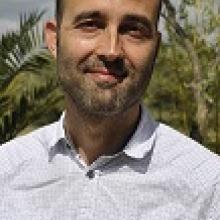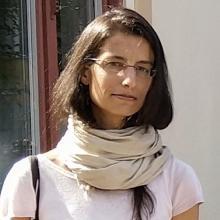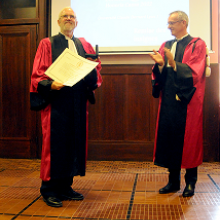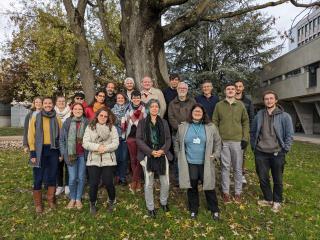Bioinformatics, Phylogeny and Evolutionary Genomics Group
Members
Maîtresse de conférences
UCBL
Tel: 04 72 44 84 87

Professeure des universités
UCBL
Tel: 33 04 26 23 44 76
Doctorante
UCBL
Enseignant-chercheur CPJ
UCBL

Directeur de recherche
CNRS
Tel: 33 04 72 44 62 97

Professeur d'université émérite
UCBL
Tel: 04 72 44 85 60
Ingénieur d'études CDD
CNRS

Directeur de recherche
CNRS
Tel: 33 04 72 43 11 67

Maîtresse de conférences
UCBL
Tel: 33 04 72 43 29 18
Doctorante
UCBL

Chargée de recherche
CNRS
Tel: 33 04 72 44 85 60

Directeur de recherche
CNRS
Tel: 04 72 44 84 87

Chargée de recherche
CNRS
Tel: 04 72 43 13 44

Directeur de recherche
CNRS

Maître de conférences
UCBL
Tel: 04 72 43 35 83

Chargée de recherche
CNRS
Tel: 04 72 44 81 42
Doctorant
CNRS

Directeur de recherche
CNRS
Tel: 33 04 72 44 62 96

Chargée de recherche
CNRS
Tel: 04 72 43 26 28
Doctorant
UCBL

Chercheur invité
UCBL
Our group focuses on two main axes: phylogenomics (i.e. the inference of evolutionary history based on genomics data) and evolutionary genomics (understanding the molecular and population processes that drive genome evolution). We see genomes both as a subject of research (how do genomes evolve, why are they structured the way they are?), but also as a main source of empirical knowledge about the macroevolutionary patterns (what do they tell us about the history of life on Earth?), or about the phenotypes and life-history strategies of organisms. Our works heavily rely on methodological developments (bioinformatics, modeling and statistical inference).
Evolution of genome architecture and expression
Genomes are the result of a long-term evolutionary process, shaped by multiple evolutionary forces. Some genomic features are adaptive (i.e. are beneficial for the fitness of organisms), others result from non-adaptive processes (random drift and biased gene conversion - BGC) or are caused by conflicts between multiple levels of selection (e.g. meiotic drive or the spread of selfish genetic elements). We explore different aspects of genome architecture (base composition landscapes, genome structure and size, impact of transposable elements, …) or functioning (gene expression, lncRNAs, epigenetic landscapes, …), and try to disentangle the relative contribution of adaptive and non-adaptive processes to their evolution. For this purpose, we consider both the molecular mechanisms (mutation, repair, recombination) and the population processes (selection, drift, BGC, …) that shape genetic variation.
Phylogenomics
We are interested in reconstructing the history of life on Earth. This research unfolds along several axes. First, we develop phylogenomic databases of aligned genetic sequences (e.g. BIBI, RiboDB or HOGENOM). Second, we conduct methodological research on how to accurately reconstruct deep phylogenies, infer divergence times, reconstruct ancestral genetic sequences, gene repertoires and life-history traits. This methodological work is translated into publicly available software programs (e.g. SeaView, PhyloBayes, Coevol). Finally, we apply these approaches to several important problems, among which: reconstructing the phylogeny of animals, of archaea, or the global tree of life; using phylogenies and ancestral gene repertoires to investigate the evolution of complex systems and the emergence of molecular and cellular functions in the three domains of life; reconstructing ancestral genetic sequences, a research activity that has industrial and biotechnological applications.
Teaching and outreach
We teach at University Lyon 1 (Master Bioinfo@Lyon), INSA, ENS Lyon, we organize bioinformatics internships. We regularly give conferences on evolution (tree of life, human evolution, genetic diversity, …).
Prospective students and postdocs are invited to apply, as we often welcome visitors for internships or research projects.
Keywords: Molecular evolution and Population Genomics; Phylogenomics; Computational Genomics; Comparative genomics; Bioinformatics; Statistical inference.
Publications
Display of 271 to 300 publications on 1109 in total
Population specific dynamics and selection patterns of transposable element insertions in European natural populations
Molecular Ecology . : 1-17
DOI: 10.1111/mec.14963
Journal article
see the publicationLife History Traits Impact the Nuclear Rate of Substitution but Not the Mitochondrial Rate in Isopods
Molecular Biology and Evolution . 35 ( 12 ) : 2900-2912
Journal article
see the publicationPRDM9 Methyltransferase Activity Is Essential for Meiotic DNA Double-Strand Break Formation at Its Binding Sites
Molecular Cell . 69 ( 5 ) : 853 - 865.e6
Journal article
see the publicationCodon Usage Bias in Animals: Disentangling the Effects of Natural Selection, Effective Population Size, and GC-Biased Gene Conversion
Molecular Biology and Evolution . 35 ( 5 ) : 1092 - 1103
Journal article
see the publicationGenomic study of a novel magnetotactic Alphaproteobacteria uncovers the multiple ancestry of magnetotaxis
Environmental Microbiology .
Journal article
see the publicationExtreme halophilic archaea derive from two distinct methanogen Class II lineages
Molecular Phylogenetics and Evolution . 127 : 46-54
Journal article
see the publicationHighly Reduced Genome of the New Species Mycobacterium uberis, the Causative Agent of Nodular Thelitis and Tuberculoid Scrotitis in Livestock and a Close Relative of the Leprosy Bacilli
MSphere . 3 ( 5 ) : e00405-18
Journal article
see the publicationChanging patterns of human migrations shaped the global population structure of Mycobacterium tuberculosis in France
Scientific Reports . 8 ( 1 ) : 5855
Journal article
see the publicationTsunami sedimentary deposits of Crete records climate during the ‘Minoan Warming Period’ (≈3350 yr BP)
The Holocene .
Journal article
see the publicationHelena and BS: two travellers between the genera Drosophila and Zaprionus
Genome Biology and Evolution .
DOI: 10.1093/gbe/evy184
Journal article
see the publicationMultiple convergent supergene evolution events in mating-type chromosomes
Nature Communications . 9 ( 1 ) : 2000
Journal article
see the publicationThe sunflower genome provides insights into Asterid evolution and relationships between paleoploidization and the genetic architecture of a major breeding trait
Second Joint Congress on Evolutionary Biology .
Conference paper
see the publicationThe Rosa genome provides new insights into the domestication of modern roses
Nature Genetics . 50 ( 6 ) : 772-777
Journal article
see the publicationSex gap in aging and longevity: can sex chromosomes play a role?
Biology of Sex Differences . 9 ( 1 ) : 1-14
Journal article
see the publicationA Survey and a Positive Psychology Intervention on French PhD Student Well-being
International Journal of Doctoral Studies . 13 : 109-138
DOI: 10.28945/3948
Journal article
see the publicationAmphioxus functional genomics and the origins of vertebrate gene regulation
Nature . 564 ( 7734 ) : 64-70
Journal article
see the publicationGenomic imprinting mediates dosage compensation in a young plant XY system
Nature Plants . 4 ( 9 ) : 677-680
Journal article
see the publicationIntegrative Mobilizable Element (IMEs): a reservoir of antibiotic resistance genes in the zoonotic pathogen Streptococcus suis
GDR 3546 - Les elements mobiles du mécanisme aux populations, une approche intégrative .
Conference paper
see the publicationL'exploration des génomes par l'outil ICEFinder révèle la forte prévalence et l'extrême diversité des ICE et des IME de streptocoques
Thesis
see the publicationA Glimpse into the World of Integrative and Mobilizable Elements in Streptococci Reveals an Unexpected Diversity and Novel Families of Mobilization Proteins
Frontiers in Microbiology . 8 : 16
Journal article
see the publicationThe obscure world of integrative and mobilizable elements
Genes . 8 ( 11 ) : 337
DOI: 10.3390/genes8110337
Journal article
see the publicationThe palaeolatitudinal distribution of fossil wood genera as a proxy for European Jurassic terrestrial climate
Palaeogeography, Palaeoclimatology, Palaeoecology . 466 ( 373–381 )
Journal article
see the publicationGenomic landscape of human diversity across Madagascar
Proceedings of the National Academy of Sciences of the United States of America . 114 ( 32 ) : E6498-E6506
Journal article
see the publicationWhole‐genome patterns of linkage disequilibrium across flycatcher populations clarify the causes and consequences of fine‐scale recombination rate variation in birds
Molecular Ecology . 26 ( 16 ) : 4158-4172
DOI: 10.1111/mec.14197
Journal article
see the publicationCovariation in levels of nucleotide diversity in homologous regions of the avian genome long after completion of lineage sorting
Proceedings of the Royal Society B: Biological Sciences . 284 ( 1849 ) : 20162756
Journal article
see the publicationGenomic distribution and estimation of nucleotide diversity in natural populations: perspectives from the collared flycatcher ( Ficedula albicollis ) genome
Molecular Ecology Resources . 17 ( 4 ) : 586-597
Journal article
see the publicationSimulation-based estimation of branching models for LTR retrotransposons
Bioinformatics . 33 ( 3 ) : 320 - 326
Journal article
see the publicationGut Protozoa: Friends or Foes of the Human Gut Microbiota?
Trends in Parasitology . 33 ( 12 ) : 925-934
Journal article
see the publicationMicrobiome intestinal ancien et problématiques médicales contemporaines
Médecine/Sciences . 33 : 984-990
Other publication
see the publicationOn the Evolution of Lactase Persistence in Humans
Annual Review of Genomics and Human Genetics . 18 ( 1 ) : 297-319
Journal article
see the publication
